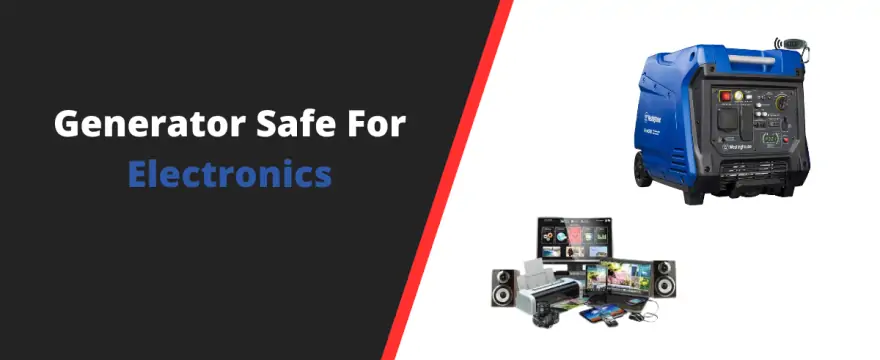Make a Generator Safe For Electronics:
When it comes into your mind How to Make a Generator Safe For Electronics use safety should always be your top priority. Generators are a common source of backup power for homes and businesses. While they can be incredibly helpful in providing electricity during a power outage, they can also be dangerous if not used properly. This is especially true when using generators with sensitive electronics, such as computers, televisions, and other electronic devices.
Understanding Generators:
Before we dive into ways to make a generator safe for electronics, it’s important to understand how generators work. There are two main types of generators: portable generators and standby generators. Portable generators are typically used for backup power in homes and businesses, while standby generators are designed to provide power for an extended period of time.
Regardless of the type of generator, they all have a few basic components. These include an engine, a fuel source (typically gasoline or diesel), an alternator, and a control panel. The engine powers the alternator, which in turn produces electricity that is sent to the control panel.
Risks of Using Generators with Electronics:
Using a generator with electronics can pose several risks. The most common risks include electrical surges, overloading circuits, and electromagnetic interference.
Electrical surges occur when the voltage in a circuit exceeds its rated capacity. This can cause damage to electronics, including short circuits, blown fuses, and damaged components.
Overloading circuits can occur when too many devices are plugged into a generator. This can cause the generator to overload, which can lead to a loss of power or damage to the generator.
Electromagnetic interference can occur when a generator produces electrical noise that interferes with the operation of nearby electronics.
10 Ways to Make a Generator Safe for Electronics:
-
Use an Inverter Generator
One of the best ways to make a generator safe for electronics is to use an inverter generator. Inverter generators produce a clean and stable source of power that is ideal for sensitive electronics. Unlike traditional generators, which produce alternating current (AC) that fluctuates in voltage and frequency, inverter generators produce a direct current (DC) that is converted to AC by an inverter. This results in a more stable source of power that is less likely to cause damage to electronics.
2.Purchase a Voltage Regulator
Another way to make a generator safe for electronics is to purchase a voltage regulator. A voltage regulator helps to ensure that the voltage produced by the generator remains constant, even under heavy loads. This can help to prevent overloading circuits and electrical surges that can damage electronics. A voltage regulator is particularly useful when using a generator with appliances that have sensitive electronic components.
-
Use a Surge Protector
A surge protector is another important tool to use when using a generator with electronics. Surge protectors are designed to absorb voltage spikes and surges, protecting connected devices from damage. They work by redirecting excess voltage to the ground wire, preventing it from reaching connected devices. It’s important to use a surge protector rated for the wattage of the connected devices to ensure maximum protection.
-
Install a Transfer Switch
A transfer switch is a device that allows you to switch between your main power source (such as the grid) and your generator. This is important for safety reasons, as it prevents power from the generator from flowing back into the grid, which can be dangerous for utility workers. It also makes it easy to switch between power sources during a power outage. A transfer switch should be installed by a qualified electrician to ensure proper installation and operation.
-
Keep Generators Outdoors
Generators should always be used outdoors to prevent the buildup of carbon monoxide gas, which can be deadly. It’s important to keep generators at least 20 feet away from buildings and other structures to ensure proper ventilation. It’s also important to keep generators dry and protected from the elements.
-
Ground the Generator
Grounding the generator is an important safety measure that can prevent electrical shocks and fires. To ground a generator, connect a copper wire from the grounding terminal on the generator to a grounding rod driven into the earth. This helps to dissipate any electrical charge and prevent electrical shocks.
-
Follow Proper Fuel Storage Procedures
Proper fuel storage procedures are important for both safety and performance reasons. Fuel should be stored in a cool, dry place away from sources of heat and ignition. It’s also important to use fresh fuel and to avoid storing fuel for more than a few months. Stale fuel can cause the generator to run poorly and can even damage the engine.
-
Properly Maintain the Generator
Proper maintenance is important for ensuring that your generator operates safely and reliably. This includes changing the oil and air filter regularly, checking the spark plug, and inspecting the fuel system for leaks or damage. It’s also important to follow the manufacturer’s recommended maintenance schedule to ensure optimal performance.
-
Avoid Overloading the Generator
Overloading the generator is a common cause of damage to both the generator and connected electronics. To avoid overloading the generator, it’s important to only connect devices that are rated for the generator’s wattage. It’s also important to avoid connecting devices that have a high startup wattage, such as refrigerators and air conditioners, all at once.
-
Follow Safety Guidelines
Finally, it’s important to follow all safety guidelines when using a generator. This includes reading the manufacturer’s instructions carefully, using the generator only in well-ventilated areas, and wearing appropriate safety gear such as gloves and safety glasses. It’s also important to keep children and pets away from the generator at all times.
Conclusion:
Using a generator with electronics can be a challenge, but by following these 10 ways to make a generator safe for electronics, you can ensure that your devices remain protected while still providing backup power when you need it. From using an inverter generator to following safety guidelines, these tips will help you keep your electronics safe and functioning during a power outage.
Buying Guide:
-
Look for Inverter Generators
When shopping for a generator, consider an inverter generator. These generators are designed with electronics in mind and produce clean and stable power, making them safe for sensitive devices. They also tend to be quieter and more fuel-efficient than traditional generators.
-
Check the Total Harmonic Distortion (THD) Level
The THD level refers to the quality of the power output. Look for generators with a THD level of 6% or less. This will ensure that the power produced is stable and safe for electronics.
-
Consider the Wattage
Make sure the generator you choose is rated for the wattage of the devices you plan to connect. Overloading a generator can damage the generator and your devices.
-
Invest in a Voltage Regulator
A voltage regulator can help protect your devices from power surges and dips. It works by stabilizing the voltage output and ensuring that it remains at a safe level for your devices.
-
Use a Surge Protector
Even with a voltage regulator, it’s a good idea to use a surge protector to provide an extra layer of protection against power surges. Make sure the surge protector is rated for the wattage of the devices you plan to connect.
-
Install a Transfer Switch
A transfer switch is a device that allows you to easily switch between your main power source and your generator. It’s recommended for safety reasons, as it prevents power from the generator from flowing back into the grid.
-
Keep the Generator Away from Your Home
Generators produce carbon monoxide, which is a poisonous gas. To prevent carbon monoxide poisoning, make sure your generator is placed at least 20 feet away from your home, with the exhaust facing away from your home.
-
Keep the Generator Dry
Water and electricity don’t mix, so make sure your generator is kept dry at all times. If you need to use the generator in wet conditions, consider using a generator tent or shelter.
-
Follow the Manufacturer’s Maintenance Schedule
To ensure your generator continues to function properly and safely, it’s important to follow the manufacturer’s recommended maintenance schedule. This typically includes oil changes, air filter changes, spark plug checks, and fuel system inspections.
-
Only Connect Devices Rated for the Generator’s Wattage
Connecting devices that are not rated for the generator’s wattage can overload the generator and damage both the generator and your devices. Make sure you only connect devices that are rated for the generator’s wattage and avoid connecting devices that have a high startup wattage, such as refrigerators and air conditioners, all at once.
By following these guidelines, you can ensure that your generator is safe for your electronics and that you can rely on it during power outages. Remember to always prioritize safety and consult with a qualified electrician if you have any questions or concerns.
FAQs:
A. Can I use any generator with electronics?
No, not all generators are suitable for use with electronics. Inverter generators are the best option, as they produce a stable source of power that is less likely to cause
electrical surges that can damage sensitive electronics.
B. Can I use a surge protector with any generator?
Yes, you can use a surge protector with any generator. It’s important to use a surge protector rated for the wattage of the connected devices to ensure maximum protection.
C. Do I need a transfer switch to use a generator?
While it’s not required, a transfer switch is recommended for safety reasons. It allows you to switch between your main power source and your generator easily and prevents power from the generator from flowing back into the grid.
D. How often should I perform maintenance on my generator?
You should follow the manufacturer’s recommended maintenance schedule, which typically includes oil changes, air filter changes, spark plug checks, and fuel system inspections.
E. Can I connect any electronic device to a generator?
No, you should only connect devices that are rated for the generator’s wattage. It’s also important to avoid connecting devices that have a high startup wattage, such as refrigerators and air conditioners, all at once.
By following these ways to make a generator safe for electronics, you can ensure that your devices remain protected while still providing backup power during a power outage. Remember to always follow safety guidelines and consult with a qualified electrician if you have any questions or concerns.
Related Buyer’s Guides
- List of 10 Best Generators for RV
- List of Top 6 Best Portable Inverter Generators
- List of Best Quiet Generator
- List of 10 Best Generators with Inverter
- List of Best Dual Fuel Generator
- List of Top 7 Best standby Generators
- List of Best Solar Generators
- List of 6 Best Inverter Generator
- List of 6 Best Camping Generators
- List of 6 best whole house generator


Leave a Reply